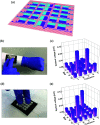Scalable and facile synthesis of stretchable thermoelectric fabric for wearable self-powered temperature sensors
- PMID: 35558227
- PMCID: PMC9091182
- DOI: 10.1039/c8ra06664g
Scalable and facile synthesis of stretchable thermoelectric fabric for wearable self-powered temperature sensors
Abstract
Wearable sensor systems with ultra-thinness, light weight, high flexibility, and stretchability that are conformally in contact with the skin have advanced tremendously in many respects, but they still face challenges in terms of scalability, processibility, and manufacturability. Here, we report a highly stretchable and wearable textile-based self-powered temperature sensor fabricated using commercial thermoelectric inks. Through various combinations of poly(3,4-ethylene dioxythiophene)-poly(styrene sulfonate) (PEDOT:PSS), silver nanoparticles (AgNPs), and graphene inks, we obtained linear temperature-sensing capability. The optimized sensor generates a thermoelectric voltage output of 1.1 mV for a temperature difference of 100 K through a combination of PEDOT:PSS and AgNPs inks and it shows high durability up to 800 cycles of 20% strain. In addition, the knitted textile substrate exhibits temperature-sensing properties that are dependent upon the stretching directions. We believe that stretchable thermoelectric fabric has broader potential for application in human-machine interfaces, health-monitoring technologies, and humanoid robotics.
This journal is © The Royal Society of Chemistry.
Conflict of interest statement
There are no conflicts to declare.
Figures





Similar articles
-
Enhanced thermoelectric performance of graphene based nanocomposite coated self-powered wearable e-textiles for energy harvesting from human body heat.RSC Adv. 2021 May 6;11(27):16675-16687. doi: 10.1039/d0ra10783b. eCollection 2021 Apr 30. RSC Adv. 2021. PMID: 35479176 Free PMC article.
-
Highly Flexible, Stretchable, and Self-Powered Strain-Temperature Dual Sensor Based on Free-Standing PEDOT:PSS/Carbon Nanocoils-Poly(vinyl) Alcohol Films.ACS Sens. 2021 Mar 26;6(3):1120-1128. doi: 10.1021/acssensors.0c02390. Epub 2021 Mar 16. ACS Sens. 2021. PMID: 33724004
-
Highly Stretchable and Stimulus-Free Self-Healing Hydrogels with Multiple Signal Detection Performance for Self-Powered Wearable Temperature Sensors.ACS Appl Mater Interfaces. 2023 Apr 12;15(14):18262-18271. doi: 10.1021/acsami.2c21663. Epub 2023 Apr 1. ACS Appl Mater Interfaces. 2023. PMID: 37002947
-
Conductive Elastomers for Stretchable Electronics, Sensors and Energy Harvesters.Polymers (Basel). 2016 Apr 5;8(4):123. doi: 10.3390/polym8040123. Polymers (Basel). 2016. PMID: 30979215 Free PMC article. Review.
-
Recent research trends in textile-based temperature sensors: a mini review.Nanotechnology. 2023 Aug 7;34(42). doi: 10.1088/1361-6528/ace913. Nanotechnology. 2023. PMID: 37473742 Review.
Cited by
-
Smart Detecting and Versatile Wearable Electrical Sensing Mediums for Healthcare.Sensors (Basel). 2023 Jul 21;23(14):6586. doi: 10.3390/s23146586. Sensors (Basel). 2023. PMID: 37514879 Free PMC article. Review.
-
Performance Optimization of Wearable Printed Human Body Temperature Sensor Based on Silver Interdigitated Electrode and Carbon-Sensing Film.Sensors (Basel). 2023 Feb 7;23(4):1869. doi: 10.3390/s23041869. Sensors (Basel). 2023. PMID: 36850466 Free PMC article.
-
A New Class of Electronic Devices Based on Flexible Porous Substrates.Adv Sci (Weinh). 2022 Mar;9(7):e2105084. doi: 10.1002/advs.202105084. Epub 2022 Jan 17. Adv Sci (Weinh). 2022. PMID: 35038244 Free PMC article. Review.
-
Beyond Color Boundaries: Pioneering Developments in Cholesteric Liquid Crystal Photonic Actuators.Micromachines (Basel). 2024 Jun 20;15(6):808. doi: 10.3390/mi15060808. Micromachines (Basel). 2024. PMID: 38930778 Free PMC article. Review.
-
A carbon nanotube-based textile pressure sensor with high-temperature resistance.RSC Adv. 2022 Aug 16;12(36):23091-23098. doi: 10.1039/d2ra04036k. eCollection 2022 Aug 16. RSC Adv. 2022. PMID: 36090403 Free PMC article.
References
LinkOut - more resources
Full Text Sources

